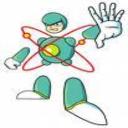Yahoo Answers is shutting down on May 4th, 2021 (Eastern Time) and beginning April 20th, 2021 (Eastern Time) the Yahoo Answers website will be in read-only mode. There will be no changes to other Yahoo properties or services, or your Yahoo account. You can find more information about the Yahoo Answers shutdown and how to download your data on this help page.
Trending News
Physics collisions?
A 0.0210 kg bullet moving horizontally at 450 m/s embeds itself into an initially stationary 0.500 kg block.
(a)
What is their velocity (in m/s) just after the collision?
Correct: Your answer is correct.
m/s
(b)
The bullet-embedded block slides 8.0 m on a horizontal surface with a 0.30 kinetic coefficient of friction. Now what is its velocity (in m/s)?
Correct: Your answer is correct.
m/s
(c)
The bullet-embedded block now strikes and sticks to a stationary 2.00 kg block. How far (in m) does this combination travel before stopping?
2 Answers
- NCSLv 72 years agoFavorite Answer
(a) conserve momentum
0.0210kg * 450m/s + 0 = 0.5210kg * V
solves to
V = 18.1 m/s
but you apparently knew that.
(b) initial KE = ½ * 0.521kg * (18.1m/s)² = 85.7 J
friction work W = µmgd = 0.3 * 0.521kg * 9.8m/s² * 8.0m = 12.3 J
and so the remaining KE is
KE' = (85.7 - 12.3) J = 73.4 J = ½ * 0.521kg * v²
and so the new velocity is
v = 16.8 m/s
which you apparently also knew.
(c) conserve momentum again:
0.521kg * 16.8m/s + 0 = 2.521kg * U
U = 3.47 m/s
so new KE is
KE" = ½ * 2.521kg * (3.47m/s)² = 15.2 J
What distance is required to do this much friction work?
15.2 J = 0.3 * 2.521kg * 9.8m/s² * d
solves to
d = 2.05 m
Hope this helps!
- electron1Lv 72 years ago
Momentum is conserved in a collision.
Initial momentum = 0.0210 * 450 = 9.45 kg * m/s
Total mass = 0.0210 + 0.5 = 0.521 kg
Final momentum = 0.521 * v
0.521 * v = 9.45
v = 9.45 ÷ 0.521
Their velocity is approximately 18.1 m/s
\(b)
The bullet-embedded block slides 8.0 m on a horizontal surface with a 0.30 kinetic coefficient of friction. Now what is its velocity (in m/s)?
The friction force causes the bullet-embedded block to decelerate.
Ff = -0.3 * 0.521 * 9.8 = -1.53174 N
a = -1.53174 ÷ 0.521 = -2.94 m/s^2
Let’s use the following equation to determine its velocity.
vf^2 = vi^2 + 2 * a * d
vf^2 = (9.45 ÷ 0.521)^2 + 2 * -2.94 * 8
vf = √[((9.45 ÷ 0.521)^2 – 47.04]
Their velocity is approximately 16.8 m/s.
The bullet-embedded block now strikes and sticks to a stationary 2.00 kg block. How far (in m) does this combination travel before stopping?
Initial momentum = 9.45 kg * m/s
Total mass = 0.521 + 2 = 2.521 kg
Final momentum = 2.521 * v
2.521 * v = 9.45
v = 9.45 ÷ 2.521
Their velocity is approximately 3.75 m/s. The acceleration is still -2.94 m/s^2. Let’s use the following equation to determine the distance they move.
vf^2 = vi^2 + 2 * a * d
0 = (9.45 ÷ 2.521)^2 + 2 * -2.94 * d
5.88 * d = (9.45 ÷ 2.521)^2
d = (9.45 ÷ 2.521)^2 ÷ 5.88
The distance is approximately 2.39 meters. I hope this is helpful for you.



